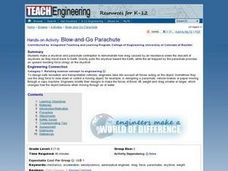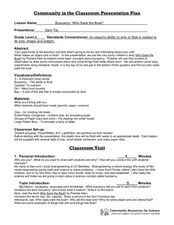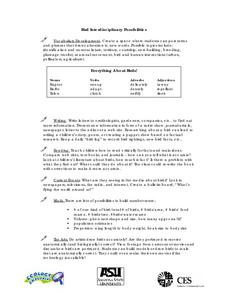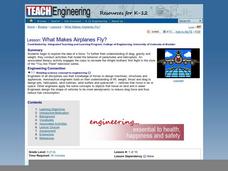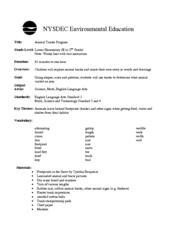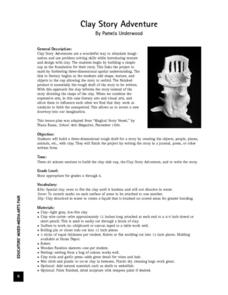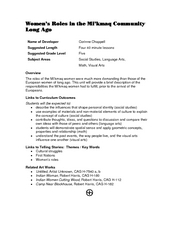Teach Engineering
Fun with Bernoulli
Reduce the pressure in the classroom. The second instructional activity in an Airplanes unit of 22 introduces the class to Bernoulli's Principle. Pupils demonstrate the principle by blowing between different objects causing a reduction...
Teach Engineering
Floaters and Sinkers
Whatever floats your boat. Young engineers learn about density by measuring the masses and volumes of boxes filled with different materials. Using their knowledge of densities, they hypothesize whether objects with given densities will...
Teach Engineering
May the Force Be With You: Lift
Get the class up and going with a instructional activity that discusses how airplane wings provide lift. Pupils use their knowledge of Bernoulli's Principle to develop an explanation of how it creates lift on airplane wings.
Curated OER
Blow-and-Go Parachute
Students design a skydiver and parachute constraption to demonstrate how drag caused by air resistance slows the descent of skydivers as they travel back to Earth. They experience how gravity pulls the skydiver toward the earth and how...
Curated OER
Water Pressure Blaster
Third graders complete an experiment to introduce them to the concept of water pressure. In this water pressure lesson plan, 3rd graders create pressure in a water bottle and observe the force of water that is created.
Teach Engineering
Extinction Prevention via Engineering
It's time to save endangered species through engineering. The third lesson in a nine-part Life Science unit has young environmentalists study species extinction. An engaging discussion leads to some ideas on how to use engineering design...
Curated OER
Buoyancy: Who Sank the Boat?
Students examine whether objects will sink or float. For this buoyancy lesson students bring in objects and experiment to see if they sink or float.
Curated OER
Chemical Wonders
Students read about and discuss how chemical engineers use different states of matter to create substances. In this chemical engineering lesson plan, students also give examples of the 3 kinds of matter.
Teach Engineering
Electromagnets
Show your class what goes on with a magnet that can be turned on and off with a resource that provides the information needed to build an electromagnet. The information allows the class to understand that creating loops with the current...
Curated OER
Salt: White Gold
Students examine the importance of salt for trade routes and the economy of a community.
Teach Engineering
Fairly Fundamental Facts About Forces and Structures
Don't twist and turn looking for a resource. The first installment of a six-part series teaches young engineers about the five fundamental forces of compression, tension, shear, bending, and torsion. These forces help explain different...
Curated OER
Bird Interdisciplinary Possibilities
Students explore birds, their territory, breeding, and seasonal movement. They research and collect information on birds through writing letters to ornithologists, reading in books, comparing web sites, and observing pictures. Students...
Curated OER
What Makes Airplanes Fly?
Students examine force and conduct activities that model parachutes and helicopters. In this airplanes lesson students identify the forces that make airplanes fly higher and land.
Teach Engineering
Magnetic Fields
Introduce your class to magnetic fields with an activity that demonstrates that a compass is affected by the magnetic field of the earth, unless a closer, stronger magnetic field is present. Pupils can use this fact in the...
Curated OER
Animal Tracks Program
Entice your learners with this lesson plan on animal footprints. After reading the story Footprints in the Snow by Cynthia Benjamin, they use photos to identify animals and their footprints. Then they participate in an activity to...
Curated OER
Engineering: Which Roof Is Tops?
Learners determine regional climates by examining photos of house roofs. They observe teacher-constructed examples of roofs and make predictions as to which style is best for snowy climates. After evaluating the examples, they record...
Curated OER
Take an Ant to Lunch
Second graders construct a model of an ant, exemplifying that ants are insects. Students gather data create a pictograph chart to show ant food preferences. Also, 2nd graders access the Internet to explore ant eating habits.
Curated OER
Clay Story Adventure
Young scholars build three-dimensional rough draft for a story by creating objects, people, places, animals, etc., with clay, and write story in a journal, poem, or other written form.
Curated OER
That's Entertainment
Second graders view examples of active lifestyles in works of Robert Harris, and list and graph their daily activities to see if they lead active lifestyles. Students then name forms of entertainment that require practice,...
Curated OER
Ramps
Students experiment to see how various objects roll down ramps. In this ramp lesson, students observe weight, size, and material of objects. Students compare speeds by using a second ramp.
Curated OER
Once Upon A Time...
Students discuss elements of fairy tales, examine selected piece of Robert Harris' art, and compose fairy tales based on what they see and imagine. Students then view homes in Harris' artwork collection, create home in which they would...
Curated OER
Women's Roles in the Mi'kmaq Community Long Ago
Fifth graders examine the roles of Aboriginal women in their community long ago. They explore the different roles Aboriginal women portray in today's society. They address any stereotyping they may have regarding Aboriginal people.
Curated OER
Roman Archy
Third graders use Google Earth to examine Roman architecture. For this ancient Rome lesson, 3rd graders visit the noted URLs to look at examples of Roman architecture. Students work in teams to examine data about the structures.



